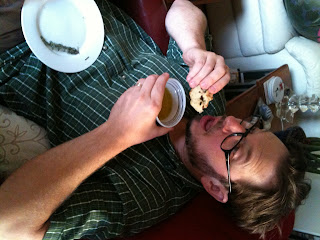Happy May Day! May the spirit of the Pagans inspire you to bring in the flowers of May and celebrate the immense fertility of the Earth. I was recently on a foraging expedition with an expert forager, Kevin Feinstein, a local wild plant forager & writer. In a wandering food expedition along the Contra Costa hills, he taught us how to recognize wild edible plants, how to prepare them, and how to respect them. For me, it was a great awakening to the bounty of nature. So accustomed to the farmer's market, I had not known the joys of what our ancestors had done long before we began domesticating plants.

Every region and climate will have its own unique plants and therefore, this is will only be pertinent to North America, near 37 degrees latitude. What is most important for sustainable foraging is harvesting only 1/3 of the plant leaf or flower, and never pulling up the roots of delicate plants. For example, we found a lovely patch of Miners Lettuce (below). This delicate plant is a wintergreen, which first appears as a spade-shaped leaf, then turns into a full circled leaf. It’s best not to pull out the shallow root so that it will return next season. It’s also best to cut the leaf at the base of the plant with scissors. This lovely lettuce has a buttery and delicate taste. I enjoyed a fresh salad with baby carrots and cherry tomatoes, topped with olive oil, salt, and fresh ground pepper. This plant was very popular with the California 49ers, who ate it while on expeditions for their precious Gold; and therefore it's local name. This delicate plant is nutritious and reseeds itself every year. How amazing is nature?!




Learning about native plants gave me great insight into the Ohlone, this region's indigenous people, who foraged from the wild for over 3,000 years. The land was covered with great Valley Oaks (right), very large trees that produce acorns. The Ohlone were able to leech the harsh tannins of the acorn by placing them in the streams and allow the running water to dissolve the tannin out. This precious seed sustained them and was their main staple. The acorns were ground down into a very nutritious paste. Their culture evolved around harvesting these acorns that did not always arrive every season, but when they did arrive it was a bountiful harvest for these people.
I also encountered the California Bay Leaf bush (left), which is 3 times stronger than the European Bay leaf. The flower buds can be picked to make capers! Cannot wait to try this. The nuts from the fruit can also be roasted and eaten, but be careful as the nut has a strong caffeine property.
The elderberry is a wonderous plant for its medicinal properties as an anti-viral. The fruit can be harvested and made into jams, jelly, or frozen for a later idea. Later in the summer, these buds (below) will be ready to harvest by gently shaking off berries from the branch. The berries are sweet and perfectly tart. It was also recommended to put the berries in Brandy or Vodka for a few weeks to make a strong medicinal tincture. Flowers appear in May or June, are a cream color, and can be used for tea.
In the foraging expedition Kevin warned of poisonous plants and never eating anything not recognized. The dreaded Hemlock plant, with purple blotches on stalk, being the very first plant that he showed us. This plant will certainly be the end of you if ingested; just as it was used for poisoning great philosophers and leaders. It is best to avoid anything that resembles wild parsley or carrot leaf plants, to be safe.
Recently I heard on NPR, a conversation with an East Coast urban forager who was speaking about how to recognize edible wild plants growing in the City; but I would discourage anyone from eating plants near a highway, growing out of the concrete, or near a parking lot; as the plant will pull contaminants through the roots. It is always best to thoroughly wash off plants in cold water. Also, urbanites must be careful with the law, as some city parks do not support foraging; even some state and national parks discourage foraging wild plants for good reason. I suppose this is the reason we have organized farming!
In your area, go out with those that have experience, Happy Foraging!
~Tarabud





































